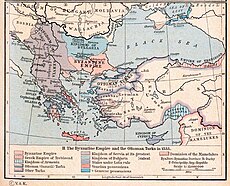Prehistoric sites in Serbia: Difference between revisions
←Created page with '{{History of Serbia}} thumb|right|200px|[[Felix Romuliana, 4th century, UNESCO]] Serbia's strategic location between two continents …' |
No edit summary |
||
| Line 1: | Line 1: | ||
{{History of Serbia}} |
{{History of Serbia}} |
||
'''Prehistoric Serbia''' is the period from the first appearance of humans on the territory of modern-day Serbia, to the establishment of the Serbs in 620AD. The best known archaeological discoveries from the prehistoric period are the [[Starcevo culture|Starcevo]] and [[Vinca culture|Vinca]] [[Prehistoric Balkans|cultures]] dating back to 6400-6200BC. |
|||
| ⚫ | |||
==Neolithic== |
|||
==Roman Serbia== |
|||
| ⚫ | |||
Serbia's strategic location between two continents has subjected it to invasions by many peoples. [[Greeks]] colonized its south in the 4th century B.C., the northernmost point of the empire of [[Alexander the Great]] being the town of [[Bujanovac|Kale]].<ref>[http://www.blic.rs/kultura.php?id=53049 Blic Online Kultura | Najseverniji grad Aleksandrovog carstva]</ref> Belgrade, [[Vinča culture|Prehistoric capital of Europe]],<ref>[http://in.reuters.com/article/worldNews/idINIndia-30447520071112?pageNumber=1 Prehistoric women had passion for fashion World | Reuters]</ref> is believed to have been torn by 140 wars since [[Roman Empire|Roman times]].<ref>[http://www.timesonline.co.uk/tol/travel/holiday_type/music_and_travel/article4385812.ece Serbia shines for the EXIT festival<!-- Bot generated title -->]</ref> The northern Serbian city of [[Sirmium]] (''Sremska Mitrovica'') was among the top 4 cities of the late [[Roman Empire]], serving as its capital during the [[Tetrarchy]].<ref>[http://hrcak.srce.hr/index.php?show=clanak&id_clanak_jezik=14662 Hrčak - Scrinia Slavonica, Vol.2 No.1 Listopad 2002]</ref> Contemporary Serbia comprises the [[Classical Greece|classical]] regions of [[Moesia]], [[Pannonia]], parts of [[Dalmatia]], [[Dacia]] and [[Macedonia (region)|Macedonia]].<ref>[[Macedonia (region)]]</ref> Around the 6th century, [[Slavic peoples|Slavs]] appeared on the [[Byzantine Empire|Byzantine]] borders in great numbers.<ref>[http://www.fordham.edu/halsall/med/mango.html Cyril Mango. Byzantium: The Empire of New Rome. Scribner's, 1980.]</ref> Slavic people have been under nominal [[Serbs|Serbian rule]] since the 7th century. They were allowed to settle in the Byzantine Empire by its emperor [[Heraclius]] after their victory over the [[Eurasian Avars|Avars]].<ref>{{cite web |url=http://www.rastko.org.rs/rastko-bl/istorija/corovic/istorija/1_3_l.html |title=Istorija srpskog naroda: Sloveni naseljavaju Balkan |accessdate= |author=Vladimir Corovic |publisher=Projekat Rastko: Biblioteka srpske kulture |language=Serbian}}</ref> |
Serbia's strategic location between two continents has subjected it to invasions by many peoples. [[Greeks]] colonized its south in the 4th century B.C., the northernmost point of the empire of [[Alexander the Great]] being the town of [[Bujanovac|Kale]].<ref>[http://www.blic.rs/kultura.php?id=53049 Blic Online Kultura | Najseverniji grad Aleksandrovog carstva]</ref> Belgrade, [[Vinča culture|Prehistoric capital of Europe]],<ref>[http://in.reuters.com/article/worldNews/idINIndia-30447520071112?pageNumber=1 Prehistoric women had passion for fashion World | Reuters]</ref> is believed to have been torn by 140 wars since [[Roman Empire|Roman times]].<ref>[http://www.timesonline.co.uk/tol/travel/holiday_type/music_and_travel/article4385812.ece Serbia shines for the EXIT festival<!-- Bot generated title -->]</ref> The northern Serbian city of [[Sirmium]] (''Sremska Mitrovica'') was among the top 4 cities of the late [[Roman Empire]], serving as its capital during the [[Tetrarchy]].<ref>[http://hrcak.srce.hr/index.php?show=clanak&id_clanak_jezik=14662 Hrčak - Scrinia Slavonica, Vol.2 No.1 Listopad 2002]</ref> Contemporary Serbia comprises the [[Classical Greece|classical]] regions of [[Moesia]], [[Pannonia]], parts of [[Dalmatia]], [[Dacia]] and [[Macedonia (region)|Macedonia]].<ref>[[Macedonia (region)]]</ref> Around the 6th century, [[Slavic peoples|Slavs]] appeared on the [[Byzantine Empire|Byzantine]] borders in great numbers.<ref>[http://www.fordham.edu/halsall/med/mango.html Cyril Mango. Byzantium: The Empire of New Rome. Scribner's, 1980.]</ref> Slavic people have been under nominal [[Serbs|Serbian rule]] since the 7th century. They were allowed to settle in the Byzantine Empire by its emperor [[Heraclius]] after their victory over the [[Eurasian Avars|Avars]].<ref>{{cite web |url=http://www.rastko.org.rs/rastko-bl/istorija/corovic/istorija/1_3_l.html |title=Istorija srpskog naroda: Sloveni naseljavaju Balkan |accessdate= |author=Vladimir Corovic |publisher=Projekat Rastko: Biblioteka srpske kulture |language=Serbian}}</ref> |
||
| Line 14: | Line 20: | ||
[[Category:Prehistory of Southeastern Europe]] |
[[Category:Prehistory of Southeastern Europe]] |
||
[[Category:History of Serbia]] |
|||
Revision as of 01:47, 13 May 2009
| History of Serbia |
|---|
 |
|
|
Prehistoric Serbia is the period from the first appearance of humans on the territory of modern-day Serbia, to the establishment of the Serbs in 620AD. The best known archaeological discoveries from the prehistoric period are the Starcevo and Vinca cultures dating back to 6400-6200BC.
Neolithic
Roman Serbia
Serbia's strategic location between two continents has subjected it to invasions by many peoples. Greeks colonized its south in the 4th century B.C., the northernmost point of the empire of Alexander the Great being the town of Kale.[1] Belgrade, Prehistoric capital of Europe,[2] is believed to have been torn by 140 wars since Roman times.[3] The northern Serbian city of Sirmium (Sremska Mitrovica) was among the top 4 cities of the late Roman Empire, serving as its capital during the Tetrarchy.[4] Contemporary Serbia comprises the classical regions of Moesia, Pannonia, parts of Dalmatia, Dacia and Macedonia.[5] Around the 6th century, Slavs appeared on the Byzantine borders in great numbers.[6] Slavic people have been under nominal Serbian rule since the 7th century. They were allowed to settle in the Byzantine Empire by its emperor Heraclius after their victory over the Avars.[7]
Throughout its early history, various parts of the territory of modern Serbia have been colonized, claimed or ruled by:
- the Greeks and Romans (conquered the indigenous Celts and Illyrians)
- the Western and Eastern Roman Empires
- challenged by the incursions of the Huns, the Ostrogoths, the Sarmatians, the Avars, the Serbs, the Frankish Kingdom, the Great Moravia, the Bulgarians and finally, the Hungarians).
No fewer than 17 Roman Emperors were born in the land that is now Serbia.[8]
References
- ^ Blic Online Kultura | Najseverniji grad Aleksandrovog carstva
- ^ Prehistoric women had passion for fashion World | Reuters
- ^ Serbia shines for the EXIT festival
- ^ Hrčak - Scrinia Slavonica, Vol.2 No.1 Listopad 2002
- ^ Macedonia (region)
- ^ Cyril Mango. Byzantium: The Empire of New Rome. Scribner's, 1980.
- ^ Vladimir Corovic. "Istorija srpskog naroda: Sloveni naseljavaju Balkan" (in Serbian). Projekat Rastko: Biblioteka srpske kulture.
- ^ Aleksandra Krsmanović. "Ave, Srbijo!" (in Serbian). Brendovi Srbije.
